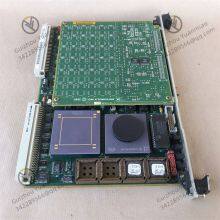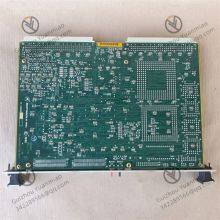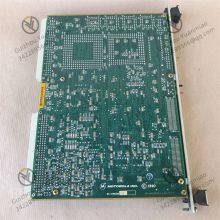Performance characteristics
Processor performance: Equipped with a 33MHz MC68040 microprocessor and a floating-point coprocessor, it features outstanding processing speed and floating-point operation performance, capable of quickly handling complex computing tasks. It is suitable for application scenarios with high requirements for data processing capabilities.
Memory configuration: Supports DRAM of 4/8/16/32/64/128/256MB. Parity check protection or ECC (Error Checking and Correction) protection can be selected, which can effectively ensure the accuracy of data storage and processing. In addition, it is equipped with 128KB SRAM and battery backup is optional for storing key data.
Storage interface: It has four 44-pin PLCC ROM sockets, which can be used for expanded storage. It is convenient for users to increase the storage capacity according to actual needs to meet the storage requirements of different programs and data.
Bus interface: It is equipped with a full 32-bit master/slave VME bus interface, which can perform high-speed data interaction with other modules through the VME bus. It can act as a master device or a slave device and play the role of a core processing unit in the VME bus system.
Communication interface: It is usually equipped with a SCSI bus interface, four serial ports with EIA-232-D buffer, Centronics printer port and Ethernet transceiver interface, supporting DMA (Direct Memory Access), which can be conveniently connected to various external devices to achieve rapid data transmission and communication.
Status indication: The front panel is equipped with multiple status indicator lights, such as FAIL, STAT, RUN, SCON, LAN, +12V (LAN power supply), SCSI and VME, etc., which can visually display the operating status of the device, network connection status, power status, etc., facilitating users to monitor the operation of the device in real time and promptly identify and eliminate faults.
Operating temperature: The equipment is designed to operate reliably within an intake air temperature range of 0°C to 55°C, featuring good environmental adaptability and meeting the application requirements of most industrial environments.
Application scenarios
Numerical control machine tools and robot control
As the core processing unit of the numerical control system, the MVME167-03A can process the position and speed data fed back by sensors in real time, and control the servo motor through high-precision algorithms to achieve precise movement of machine tool tools or industrial robot mechanical arms. For example, in the processing of automotive parts, five-axis machine tools can be controlled to complete the milling of complex curved surface parts, with processing accuracy reaching the micrometer level. In the welding robot system, multi-axis movements can be coordinated to ensure the stability of the welding trajectory and the welding quality.
Control of new energy equipment
The control system applied to wind turbines or solar inverters processes environmental data such as wind speed and light intensity to optimize power generation efficiency. In wind power generation, the pitch Angle of the wind turbine is adjusted according to the wind speed to ensure that the wind turbine can generate electricity efficiently at different wind speeds. At the same time, the key control program is protected by ECC memory to avoid equipment shutdown due to data errors.
Avionics equipment and test systems
As the core module of airborne electronic equipment, it is used for data processing in the flight control system, such as receiving attitude data from gyroscopes and accelerometers, calculating flight trajectories and outputting control signals to the servo. Or in the ground test system, simulate the signals of aircraft sensors to conduct functional tests on avionics equipment. Its wide-temperature design (0°C to 55°C) and anti-interference capability can meet the strict requirements of the aviation environment.
Radar and communication equipment
In military radar systems, the MVME167-03A can process echo signals in real time for target detection and tracking. In communication base stations, as baseband processing units, they complete signal encoding, decoding and data transmission to ensure the reliability of communication. For example, in the shipborne communication system, it works in coordination with other modules through the VME bus to achieve real-time processing of multi-band signals.
Control of medical imaging equipment
The imaging control unit used for large medical equipment such as CT and MRI processes the raw data collected by the detector and reconstructs the image through floating-point operations. For example, in CT equipment, this module can quickly process X-ray attenuation data, generate high-resolution tomographic images, and at the same time connect to the storage device through the SCSI interface to achieve high-speed storage of image data.
Traffic signal and monitoring system
In intelligent transportation systems, it is used for the timing control of traffic signals and the processing of road condition monitoring data. The duration of traffic signals is dynamically adjusted according to the traffic flow, and the data is uploaded to the traffic management center via Ethernet. Its highly reliable design can meet the demand for continuous operation for 7×24 hours and reduce traffic congestion caused by system failures.
Petrochemicals and Process Control
In the DCS systems of oil refineries and chemical plants, process parameters such as temperature, pressure and flow rate are collected. The valve opening degree and pump speed are adjusted through the PID control algorithm to ensure the stability of process parameters of equipment such as reaction vessels and distillation towers. For example, in an ethylene cracking unit, precisely controlling the temperature of the cracking furnace can increase the ethylene yield and prevent the equipment from overheating and getting damaged.
Environmental monitoring and environmental protection equipment
It is used for the automatic control of sewage treatment plants and waste gas treatment systems, to monitor water quality (COD, pH value) or waste gas concentration in real time, and adjust parameters such as dosage of chemicals and aeration time based on the data to ensure that the treated pollutants are discharged up to standard. Meanwhile, the remote monitoring terminal is connected through the serial port to achieve remote operation and maintenance of environmental protection equipment.

Send Inquiry to This Supplier
You May Also Like
-
MOTOROLA MVME162P-244L Embedded ComputerNegotiableMOQ: 1 Piece
-
MVME162-533 Motorola High-performance Embedded ControllerNegotiableMOQ: 1 Piece
-
MOTOROLA MVME162-530A Embedded CPU BoardNegotiableMOQ: 1 Piece
-
Motorola MVME162-512 High-performance VMEbus Industrial Control ModuleNegotiableMOQ: 1 Piece
-
MOTOROLA MVME162-410 CPU ControllerNegotiableMOQ: 1 Piece
-
MOTOROLA MVME162-403 Embedded ControllerNegotiableMOQ: 1 Piece
-
MOTOROLA MVME162-353 Embedded Controller ModuleNegotiableMOQ: 1 Piece
-
MOTOROLA MVME162-262 Dual-height VME Controller ModuleNegotiableMOQ: 1 Piece
-
MVME162-220 MOTOROLA Single-board Computer Series ModuleNegotiableMOQ: 1 Piece
-
MOTOROLA MVME1603-042 Industrial Computer ModuleNegotiableMOQ: 1 Piece













































